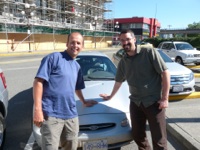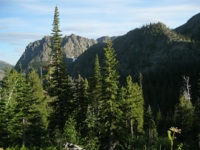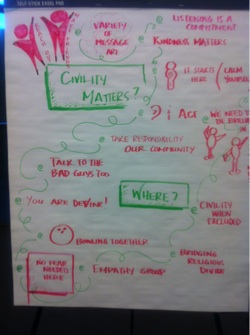I am grateful for the last ten days. Very unique. Firsts. Things that in the past I would not have let myself do or would not have had the freedom to do. A bit of writing about it now as I approach the Salt Lake City airport via Seattle.
Part one was a road trip with my good friend Roq. I flew to Fairbanks, Alaska, where he met me. We stayed a night with new friends, Julie and Doug Smith. Then on to Little Gold, Yukon where Roq was stationed for a summer work assignment.  Our trip was to road-trip from there down through the Yukon (with stops in Dawson City and an overnight in Whitehorse). Then down through British Columbia (with stops near Muncho Lake and in Quesnel) before reaching Vancouver.
Our trip was to road-trip from there down through the Yukon (with stops in Dawson City and an overnight in Whitehorse). Then down through British Columbia (with stops near Muncho Lake and in Quesnel) before reaching Vancouver.
Our trip was to return Roq to Bowen Island. It was to meet again as friends. To paddle, so to speak, into some of our current learning and questions with each other. To laugh. A lot. To be really goofy. And really serious.
There are many reasons that this trip is holding my attention. As I think of hosting conversations, one that becomes clear is that we had no agenda. A direction, yes. But no hard and fixed agenda for our conversation. And not really for the physical journey we took. We got in the car. We drove. We talked. We meandered in and out of topics. The beauty of meandering was spectacular for me. A chance to release concerns about time and to do so in the company of good friend. And of course, in the spaciousness of five days, perhaps even moreso, in our relationship to spaciousness, we covered all that I would have hoped for. Such a treat to release into what Roq and I began to reference as the kairos of time more than the kronos of time.
What happens when we meet as human beings to explore with one another? What happens when we trust that the things we give our attention to will serve as helpful doorways into the whole of what we might want to cover? What if our work was just simply wholing, as Roq referenced it in out travels? What if meandering, and noticing what holds our attention, were spot on for core learning and creation strategy in organizations?
Part two was a back-packing trip near the Esmerelda Peaks in Washington State. This was my first back-packing trip. I was quite stunned to think of how much weight each of us would be carrying. And wondering if I would be able to make it. My camping instincts are reasonably good, but I don’t have the back-packin g experience. Fortunately, I had the good help of my partner Teresa, her kids Patrick and Kate, and our Oregon friends Jeff, Jill, and their two kids.
g experience. Fortunately, I had the good help of my partner Teresa, her kids Patrick and Kate, and our Oregon friends Jeff, Jill, and their two kids.
Beyond learning how jello-like my legs could feel, what a fantastic experience for me to again, wander into a different relation with time. No email. No computer. The first time that I’ve gone without email for four days in probably the last ten years.
Again, of all the things that hold my attention from this trip, one is that of feeling healthy in my body. Yes. Four days of hiking. Enough to stretch. Enough to feel tired. Enough to build a bit of muscle and cardio. All good. But perhaps even moreso, feeling myself in relation to a big, beautiful, gorgeous expanse of land, trees, mountains, peaks, creeks. I see all of this as living system with a healthy, undeniable wholeness in it. It reminded me of something my friend Toke once shared — I am nature. To strip down some of the human created systems to feel the identity and rhythm of self as nature — what a treat.
Again, with appreciation for this experience, what becomes possible when we give primary attention in organizations to a wholeness and health? What happens when we welcome a timing that has very natural rhythm to it, one that feels more apparent in nature? What energy becomes released to clear the way for the important work many of us crave?
Many more questions. But enough for now. How important and well it feels in this moment to remember an unplugged quality and the wholeness experience of these two journeys. And how lovely to feel a freedom and clarity and partnership of offering in human systems.

 Our trip was to road-trip from there down through the Yukon (with stops in Dawson City and an overnight in Whitehorse). Then down through British Columbia (with stops near Muncho Lake and in Quesnel) before reaching Vancouver.
Our trip was to road-trip from there down through the Yukon (with stops in Dawson City and an overnight in Whitehorse). Then down through British Columbia (with stops near Muncho Lake and in Quesnel) before reaching Vancouver. g experience. Fortunately, I had the good help of my partner Teresa, her kids Patrick and Kate, and our Oregon friends Jeff, Jill, and their two kids.
g experience. Fortunately, I had the good help of my partner Teresa, her kids Patrick and Kate, and our Oregon friends Jeff, Jill, and their two kids.